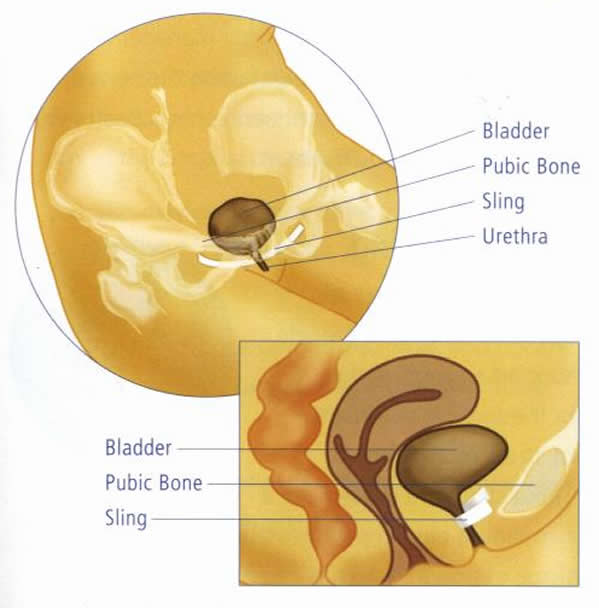Overview
What is a Trans-Obturator Sling?
A trans-obturator sling procedure corrects stress incontinence by supporting your urethra to keep it in its correct position. Currently, Trans-obturator sling procedures have a success rate of about 90%.
Stress incontinence can occur when weak pelvic floor muscles, or pressure from other organs shift or weaken the bladder neck. When the bladder neck is out of place, the urethral sphincter may not be able to keep the bladder neck closed under physical stress. The surgically implanted sling corrects stress incontinence by supporting and repositioning the bladder neck and urethra in their correct position, which can help the urethral sphincter function properly. The end result is that after a sling procedure, most women can regain control of their bladder. The image below is an example of a trans-obturator sling. The sling “cradles” the urethra to prevent urinary leakage.
Female Stress Urinary Incontinence (SUI)
Female stress incontinence can develop slowly a you age, and may often be a result of chlidbirth. It generally occurs when your pelvic muscles are not strong enough to keep the opening from the bladder neck closed when you are under physical stress including:
- Laughing
- Lifting
- Coughing
- Exercising
- Increasing abdominal pressure in any other way
Another type of stress incontinence is called intrinsic sphincter deficiency. It occurs when the urethral sphincter, which opens and closes the bladder neck opening, does not function properly. Often, intrinsic sphincter deficiency occurs in conjunction with female stress incontinence.
In addition to stress incontinence, there are other types of incontinence, such as urge incontinence, and overflow incontinence. Each is caused by a variety of conditions, such as:
- Neurological diseases
- Birth defects
- Multiple sclerosis (MS)
- Spinal cord injury
- Pelvic surgery
How is the TOT Sling placed?
Trans-obturator (TOT) sling placement is performed at Urology Associates of Central California in our freestanding Ambulatory Surgery Center located on the same campus as your urologist’s office.
During a trans-obturator sling procedure, your urologist will place the center of the sling beneath your urethra. To place the sling, a small incision is made in the vagina. The length of the incision will depend on the severity of your condition and your urologist’s approach.
When the sling is put in its desired position, it forms a cradle around your urethra, which provides the support that you need. This support holds the urethra in its correct position, which corrects stress incontinence.
After the procedure, your urologist may recommend that you use medication or other management products, but this will depend upon the severity and type of your original incontinence. Your urologist will discuss this with you in detail.
Pre-Operative Instructions Diet and Medications
- Do not eat or drink anything after midnight prior to surgery
- A Registered Nurse (RN) will contact you to obtain your medical history, provide you with complete instructions for the procedure, and answer any questions.
- Please notify the Surgery Department if you are taking any blood thinning medications in advance when scheduled for the procedure.
- A Registered Nurse (RN) will instruct you regarding what medications to take prior to surgery. If the RN instructs you to take any medication(s) the morning of your procedure, please take them with only a sip of water.
Special Instructions
- Wear loose fitting clothing.
- Leave all valuables at home such as jewelry, watches, and large amounts of cash.
- You must have a friend or family member drive you home after your surgery. If this arrangement is not made, your procedure may be canceled.
- You will be discharged according to your physician’s orders. For your own safety, it is important that you do not drive or operate machinery, drink alcohol, make important decisions, or conduct business transactions.
- Also, it is advised that an adult stay with you the first post-operative night.
Post-Operative Instructions
Diet
Unless instructed otherwise by your urologist, after surgery you may resume your normal diet. Start with liquids and advance as tolerated. Nausea usually decreases as anesthesia wears off.
Activity
NO heavy lifting, pushing, or pulling. NO swimming, heavy impact aerobic exercises, and NO sexual intercourse until advised by your doctor.
Medications
Resume your regular prescription medicine unless you have been told otherwise. If you have any questions, consult with your urologist. Do not take aspirin unless advised by your doctor. If you need medication stronger than plain Tylenol to relieve pain, call your urologist.
Dressing Care
Change pad frequently. Do not use tampons until advised by your urologist.
Bathing
You may shower. No douches or tub baths, and no spa until advised by your urologist.
General Instructions
Report the following to your urologist immediately: any temperature elevation of 101 degrees or over, chills, or shivering.
Special Instructions
If heavy flow (one pad per hour), passing of large clots, severe abdominal pain, or cramping occurs, call your urologist.


